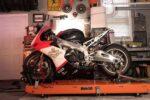II’ve been wanting to try one of those cool ADV helmets with the neat dirt-bike style brim ever since watching Ewan and Charley ride around the world. I finally got one! And I’ve been riding around in it all summer.
So, the AX-8 started life as a dirt bike helmet, but it was so popular that AGV basically drilled two holes in the side and fit a traditional face shield.
The helmet is gloriously light, because of the SSL (Super Super Light) carbon, Kevlar and fiberglass shell construction, it weighs a mere 3.4 lbs, or 1.5 kilos. For comparison, my previous Arai RXQ weighs 3.6 lbs, or 1.6 kilos. And I can tell you, that 100 gram difference adds up at the end of a long day.
I don’t really ever ride off road on my Multistrada so the need to run goggles doesn’t really apply to me, but some of the other “dirt” features make it really great for real-world street use.
So, let’s talk about the most notable design feature first – the bill/beak thing on the top.
Not only does the sun-shade-brim-visor thing look really cool, it does have some real-world applications that will make it hard for me to go back to a non-visor helmet.
Most notably is the ability to tip your head down when riding into the sun. A lot of people will put tape across the top of their visor to protect from sun glare, but this works better because you are not limiting your visibility the rest of the day.
Second, when riding in the rain and a big semi comes the other way spewing massive amounts of mist and debris, you can, again, tip your head down, and protect you visor from all the overspray. Even riding in just a drizzle, the visor helps keep the face-shield clearer.
And third, when riding in dappled lighting, the beak helps keep the face shield in the shade so you get a lot less glare and splotchy lighting, making it a lot easier to see clearly in mixed light settings.
What about turbulence? Well, I don’t like windscreens, so even my touring bike has the smallest screen you can get, so I see more wind than most touring riders and what’s amazing is that I cannot tell their is a visor up there for 95% of my riding. There is virtually no drag unless I look straight up. Even looking over my shoulder to check a blind spot, no turbulence.
However, if it’s really windy, and/or you are doing high-speed freeway blasts then you can feel the visor is up there. In most cases, the drag can be minimized by holding your head at a particular angle.
But if your riding consists of a lot of high-speed freeway blasting, then the visor would probably get old fairly quickly. But if you get into a situation where the wind is just killing you, you can remove the bill/beak thing as each helmet comes with shorter screws and little clear panels so you can remove it if you want.
But for me and my use case, I’m almost always on smaller country roads or mountain canyons so the benefits far outweigh that one pitfall. Plus, I’d imagine if you have a larger windscreen then it’s likely not going to be a factor at all.
One last thought about the visor, is that it chanels a fair bit of wind over the top of the helmet which makes the vents on the top of the helmet really, really work. When they are open, you can literally feel wind running over the top of your head – a great feature on those really hot days.
Sizing the helmet was pretty straight-forward. I wear a size small helmet, so I ordered a small helmet. The cheekpads were a little thinner than I would have liked, so after the first trip, I ordered a thicker set. Confusingly, the smaller sized cheekpads are thicker and the larger sized cheekpads are thinner. Go figure.
Because the helmet was engineered to withstand lots of dirt, a lot of the liner is protected with this rubber so the helmet stays cleaner. And even though I ride with my visor closed almost all the time, this rubber helps keep the helmet a lot cleaner. Also, you can remove the chin vent in the event that you really need a lot more air, or if you just want to clean out any dead bugs or debris. And because this is so far away from your mouth, the helmet is a bit louder, particularly if you ride without the chin curtain.
The only other thing I’m not crazy about is that to remove and replace the visor, you have to remove two screws. It’s not the end of the world and I tend to ride in my dark smoke visor all the time, halfway as an excuse to stop riding before it gets dark. The added hassle of switching visors is one more reason to keep me from riding at night, so this doesn’t really bother me much.
One other contributing factor to not switching lenses… I’d need a trailer to carry a spare! The result is a wonderfully large view port, but I don’t have anywhere to put a visor this big in my luggage, so I don’t even carry one. (joke about the tinted visor coming on a flatbed trailer?)
So, in conclusion; I purchased this on a whim because I’ve always wanted to know how they work, but I am over the moon about this AX-8 Dual. It may not work for every kind of rider out there, and it does have some limitations, but it’s no wonder so many adventure and touring riders run these helmets. I love the aesthetic, I mean you look like Gunny from Halo, I love how the visor helps you deal with different lighting situations, and I love the lightweight. This dirt bike helmet, that AGV modified for street use, has quickly become one of my favorite touring helmets of all time.






